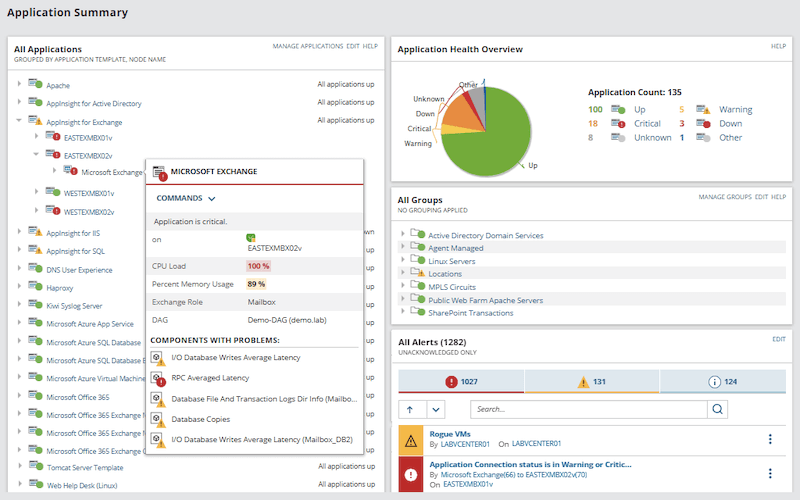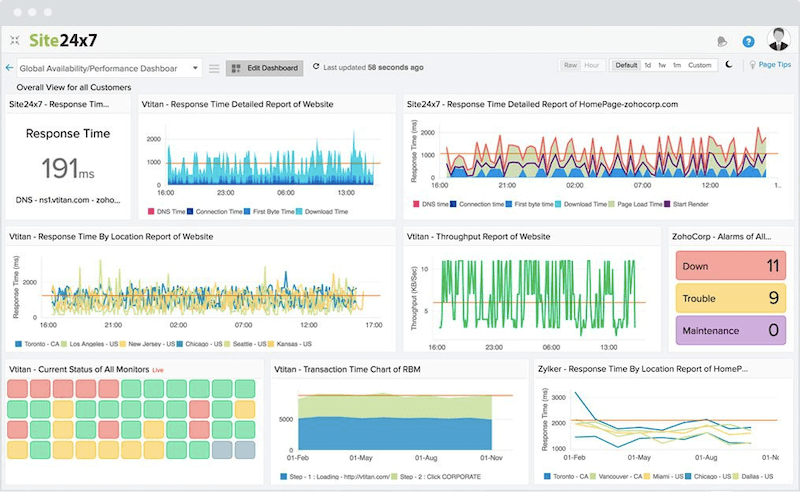We may earn a commission if you make a purchase through the links on our website.
The Definitive Guide to JBoss
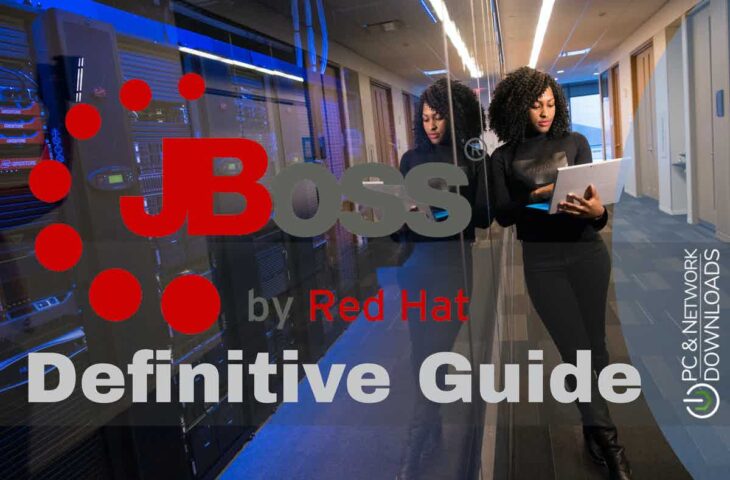
UPDATED: October 12, 2022
JBoss Application Server (JBoss AS) is one of the most up-to-date and popular Application Server (AS) frameworks, built especially for Java applications. JBoss is an open-source and cross-platform Java application server which is also an excellent option for applications that need the full functionality of the Java Enterprise Edition.
In this post, we will go into detail about the JBoss application server. We will learn about its community and Enterprise versions, how to install them, configure them, and deploy applications. In the last sections, we listed the top six JBoss monitoring tools that will help you take JBoss to the next level.
What is the JBoss Application Server?
JBoss AS is an abbreviation of JavaBeans open-source software Application Server. JBoss AS is a free, open-source, cross-platform fully-featured application server developed by Red Hat. With the JBoss AS framework (now rebranded as WildFly starting from JBoss AS version 7), you can build, deploy and host very highly-transactional Java services and apps at scale.
The JBoss project also grew into JBoss EAP — the Enterprise Application Platform. The JBoss EAP is also open-source and can be used for free on development. But Red Hat charges additionally to use JBoss EAP in production and for the subscription for support.
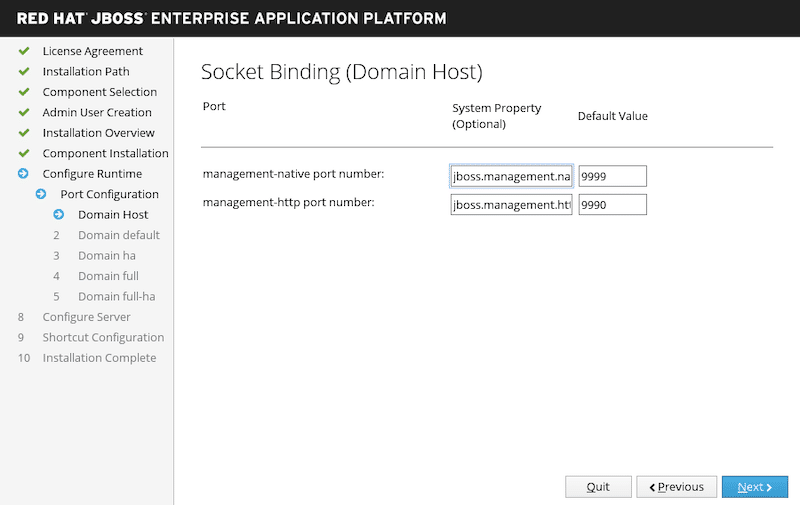
JBoss AS overcomes open-source challenges such as the lack of support and compatibility shortcomings by offering the Red Hat JBoss Enterprise Application Platform (JBoss EAP) 7.1, which is Java Enterprise Edition 7 (EE7) compliant. In addition, the JBoss EAP provides enterprise-grade security, performance, and scalability for any environment.
The JBoss framework can be used with any operating system, including Windows, OS X, UNIX, and Linux.
JBoss EAP 7 Key Features
- Use standalone or managed domain The JBoss EAP gives the option for a managed domain, which is used when you have multiple instances of JBoss AS (various servers) and need a way to manage all from a central place. You can still use the standalone server (default mode) to run the JBoss framework as a single server instance. Developers can use both modes during development or production.
- Java Enterprise Edition 7 Compliant The JBoss EAP 7.0 is a certified implementation of the Java Enterprise Edition 7 (EE7) platform and web profile specifications.
- An advanced console and CLI for management New interfaces for standalone or domain. The CLI for management includes a batch mode for scripting and automating management tasks.
- Modular class-loading JBoss EAP is built with a modular structure that allows you to enable services only when required, thus improving startup speed. With JBoss EAP 7.0, you can load and unload modules on-demand. Modular class-loading enhances performance and reduces startup and reset times.
Beginners Guide to JBoss Installation
In this section, we’ll provide a brief guide on how to install JBoss. The latest two JBoss AS versions are JBoss EAP 7 and WildFly 26.0.1.
To download JBoss
- The two ways to install JBoss are; one is through the source code format and two via the binary format. Both are available from the community-based SourceForge repository (http://sourceforge.net/projects/jboss). For beginners, the binary form is the easiest to understand and install. The file format of binary distribution is available in .tar.gz, or .zip.
- To find older versions of the JBoss AS framework (no longer maintained or supported), go to https://jbossas.jboss.org/downloads.
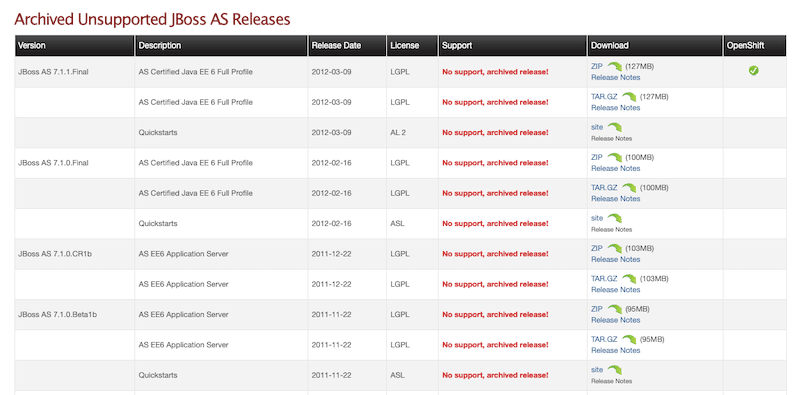
- JBoss officially recommends upgrading to the latest JBoss EAP (Redhat JBoss Middleware) or WildFly versions (GitHub repository https://github.com/wildfly/wildfly) to avoid security vulnerabilities or performance degrade.
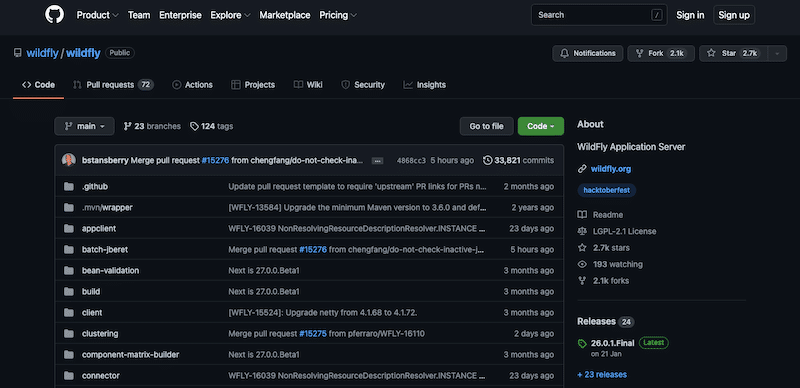
JBoss EAP Installation
As per recommendations from the JBoss AS, avoid installing old JBoss versions. In this section, we will install JBoss EAP.
- For JBoss EAP, you should set up an account on the Red Hat Customer Portal.
- There are three methods for installation: ZIP, JAR, or RPM installation. Their requirements:
- For the zip installer, ensure that JDK (1.8) is installed.
- For RPM, ensure you register to the Red Hat Enterprise Linux server.
- You should have complete administrative rights for any of the installation methods.
- To install the Zip version:
- Extract the Zip drive.
- $ unzip jboss-eap-7.x.x.zip
- For Windows server, simply right-click > Extract All.
- Note: Avoid extracting the contents of the downloaded file to a directory that has namespaces, as you might end up with errors during the installation process.
- The JBoss EAP installation top-level directory is referred to as the EAP_HOME variable. This variable denotes the patch to the JBoss EAP installation. You can replace the EAP_HOME variable with the actual path for your installation.
- For more information on the installation process, refer to the latest JBoss EAP (ver 7) documentation.
JBoss (WildFly) Installation
The following section shows the installation of JBoss WildFly’s version.
- WildFly can be installed from the Zip distribution, Galleon, or a bootable JAR. We’ll show you how to install WildFly from a zipped distribution. You can install WildFly on any system that supports zip installations.
- Download the WildFly release zip and extract it to complete the server installation. The installation supports both standalone and managed domain operating modes. It is important to note that these modes (domain and standalone) determine how servers are managed.
- For the latest WildFly (26.0.1,) it is recommended to use Java SE 8 or later. For more information, refer to the latest WildFly documentation.
Accessing the standalone server
- Configuration files for the standalone mode are saved as standalone.xml (default). While the configuration files for the domain mode are saved as domain.xml.
- To start WildFly with the default standalone web profile, change the directory to $JBOSS_HOME/bin.
- The configuration files (./domain.sh) and (./standalone.sh) can be found at:
- Standalone server directory: $JBOSS_HOME/standalone/configuration
- Domain server directory: $JBOSS_HOME/domain/configuration
Deploying on the JBoss AS Framework
In the previous sections, we covered how to install and configure JBoss. But setting up JBoss is only half of the story. Now we have to take a step forward and deploy a Java application.
There are three ways you can deploy a Java application in JBoss AS
a. File System Although file system is the traditional approach to deploying applications, this method is available in standalone mode only. To deploy an application using the file system, you just need to copy the archive.zip into the deployment directory. As an example:
$ cp javaapp01.war /opt/wildfly-14.0.0.Final/standalone/deployments
b. Management interfaces You can use the management interfaces like CLI or Admin console if you want to deploy applications on a JBoss (WildFly) domain or standalone. The default URL for JBoss’s WildFly Web console is http://localhost:9990. To deploy applications on the web console, open the Deployments and select “Add”.
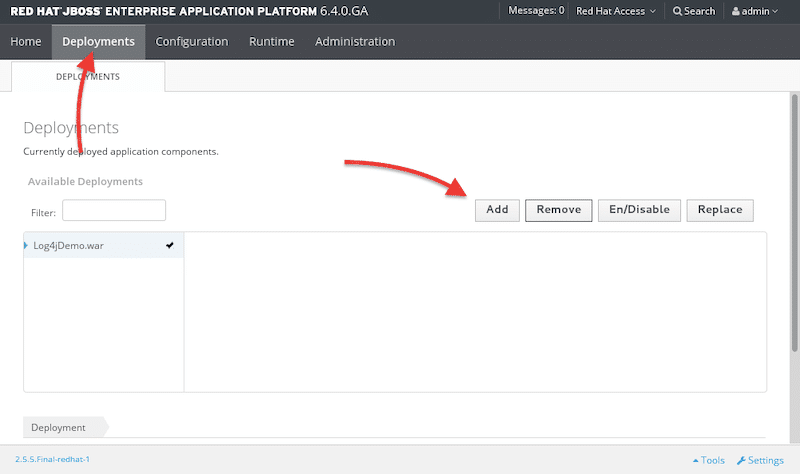
- If you are on domain server mode: Click on Deployments > Content Repository > Add.
c. Use a Maven plug-in for deploying WildFly applications. Download the WildFly Maven Plugin (wildfly-maven-plugin) to deploy, redeploy, under deploy, and run any application.
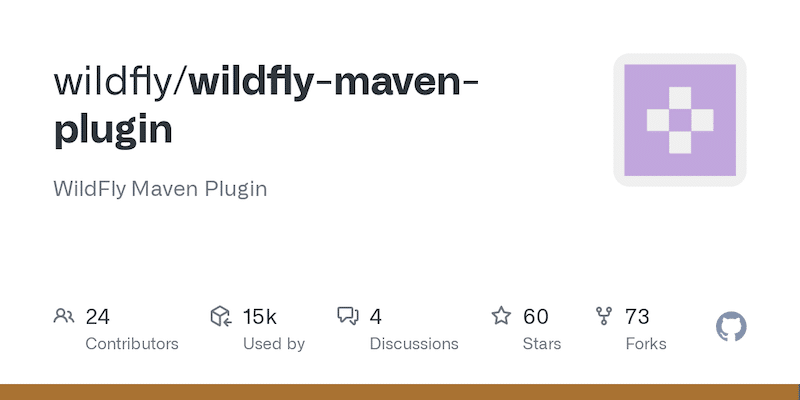
Essential JBoss Monitoring Tools
Now that you know how to set up the JBoss server, you can start building and deploying Java applications. Now you need to take your JBoss efforts to the next level by ensuring that your infrastructure and apps are run smoothly.
Below are some of the best JBoss monitoring tools available in the market.
1. SolarWinds Server & Application Monitor – FREE TRIAL
SolarWinds® Server & Application Monitor (SAM) is a robust server and application monitoring solution. With SAM, you can monitor on-premise resources or the cloud (IaaS, PaaS, and SaaS), including Azure and AWS. SAM comes with more than 1200 monitoring templates to ensure all your Java applications and underlying infrastructure runs at the highest performance.
- You can monitor JBoss AS and all its components’ health, availability, and performance.
- Improve troubleshooting by solving memory leaks in Java Runtime Environment.
- Keep track of the server’s health can capacity, including CPU, memory, and disk usage.
- Monitor other vital application aspects such as Oracle, MySQL, Apache, and Tomcat.
Pros:
- Designed with large and enterprise networks in mind
- Supports auto-discovery that builds network topology maps and inventory lists in real-time based on devices that enter the network
- Has some of the best alerting features that balance effectiveness with ease of use
- Supports both SNMP monitoring as well as packet analysis, giving you more control over monitoring than similar tools
- Uses drag and drop widgets to customize the look and feel of the dashboard
- Robust reporting system with pre-configured compliance templates
Cons:
- Designed for IT professionals, not the best option for non-technical users
Register to SolarWinds Server & Application Monitor for a fully-functional 30-day free trial.
2. Site24x7 Application Performance Monitor – FREE TRIAL
Site24x7 is an all-in-one cloud-based performance monitoring solution for DevOps and IT Operations. It monitors websites, servers, cloud, networks, application performance, and real users. The Site24x7's APM builds an app interdependencies maps and links front-end systems through technologies like JBoss to underlying resources of the server. Site24x7 supports a Java agent for JBoss EAP 6.2.x and above to help collect vital information.
Site24x7 APM features:
- Monitor application behavior in real-time.
- Analyze parameters that impact application performance.
- Trace errors and exceptions across your architecture.
- View application logs and performance issues.
Pros:
- One of the most holistic monitoring tools available, supporting networks, infrastructure, and real user monitoring in a single platform
- Uses real-time data to discover devices and build charts, network maps, and inventory reports
- Is one of the most user-friendly network monitoring tools available
- User monitoring can help bridge the gap between technical issues, user behavior, and business metrics
- Supports a freeware version for testing
Cons:
- Is a very detailed platform that will require time to fully learn all of its features and options
Sign up to start your Site24x7 30-days free trial.
3. AppDynamics
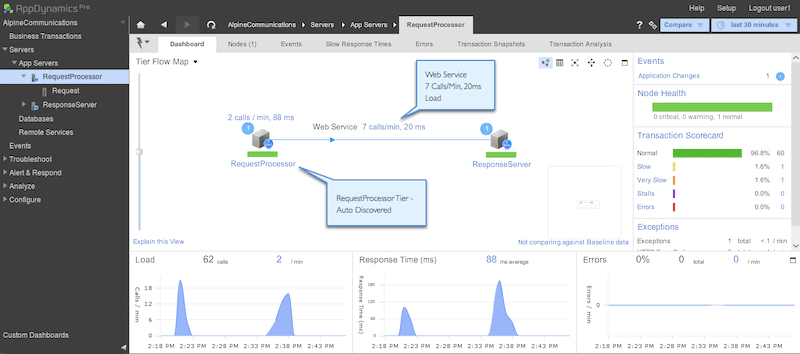
AppDynamics by Cisco is an Application Performance Management (APM) and full-stack observability solution. It uses Artificial Intelligence (AI) to improve the visibility into your IT infrastructure and applications and to identify incidences, solve them, and prevent them from happening again.
The APM component of Appdynamics provides a JBoss and WildFly monitoring tool to keep end-to-end visibility into the performance and health of Java applications and JBoss's components. AppDynamic uses Java App Server agents installed on Red Hat JBoss EAS or JBoss WildFly AS. Such agents can automatically discover the JBoss framework and services and collect application data and metrics.
Pros:
- Tailored for large-scale enterprise use
- Excellent dependency mapping and visualizations to help troubleshoot complex application systems
- Includes a free version
Cons:
- Would like to see more reporting and monitoring templates
AppDynamics offers a free 15-day SaaS trial.
4. ManageEngine Applications Manager
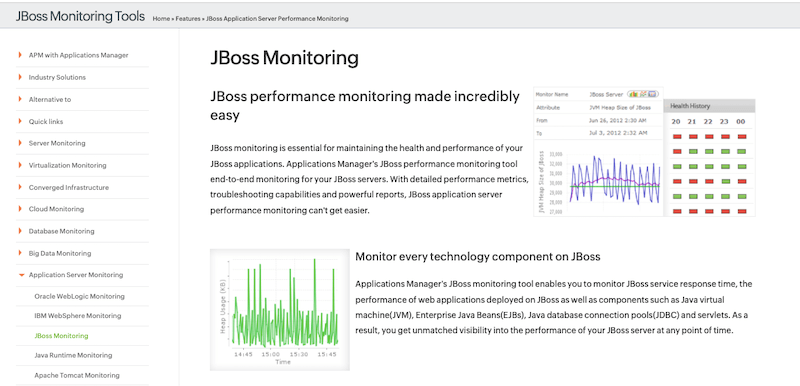
Applications Manager from ManageEngine is a robust APM tool that provides visibility into the performance of applications and infrastructure. It helps you identify and resolve performance issues across the entire application stack. It can also ensure end-user experience and improve and automate IT processes.
Manage Engine can monitor a large variety of application servers, including JBoss Servers up to version 7.x, and WildFly 8.x. Below are a few features.
- Maintain the health and performance of your JBoss applications.
- Monitor every single component related to JBoss.
- Keep track of the connectivity between JBoss AS and databases.
- Automate corrective actions in production, such as restarting the JBoss server.
Pros:
- Offers on-premise and cloud deployment options, giving companies more choices for install
- Can highlight interdependencies between applications to map out how performance issues can impact businesses operations
- Offers log monitoring to track metrics like memory usage, disk IO, and cache status, providing a holistic view into your database health
- Can automatically detect databases, server hardware, and devices in real-time
Cons:
- Can take time to fully explore all features and options available
Download a 30-day free trial of Applications Manager of the Professional/Enterprise.
5. Instana
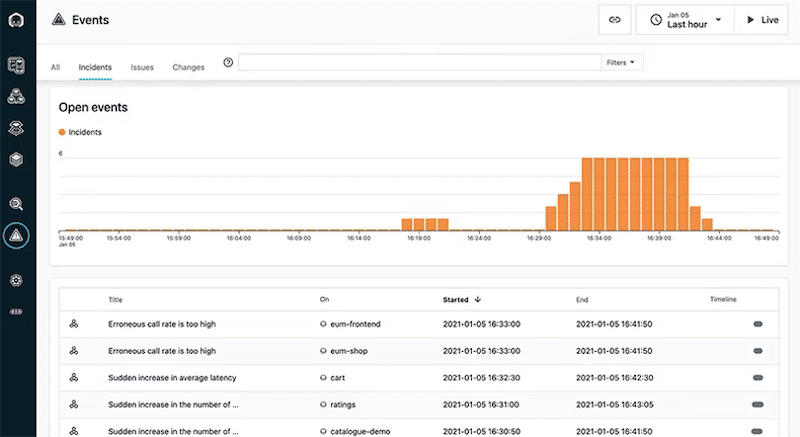
Instana is Enterprise-class observability and APM solution for cloud-native applications and services. It automates the monitoring, tracing, and profiling and provides the entire context across applications and infrastructure.
Instana's APM automates discovery, mapping, and configuration. In addition, it also provides an AI-enabled troubleshooting process to predict incidents and automatically solve them. The APM also provides JBoss AS monitoring and performance management.
Pros:
- Ideal for monitoring microservices and cloud apps
- Desgined with enterprise teams and operations in mind
- Offers a wide variety of integrations and support
Cons:
- Better suited for enterprise companies that rely on cloud services
Sign up for your Instana 14-day Free Trial.
6. eG Enterprise
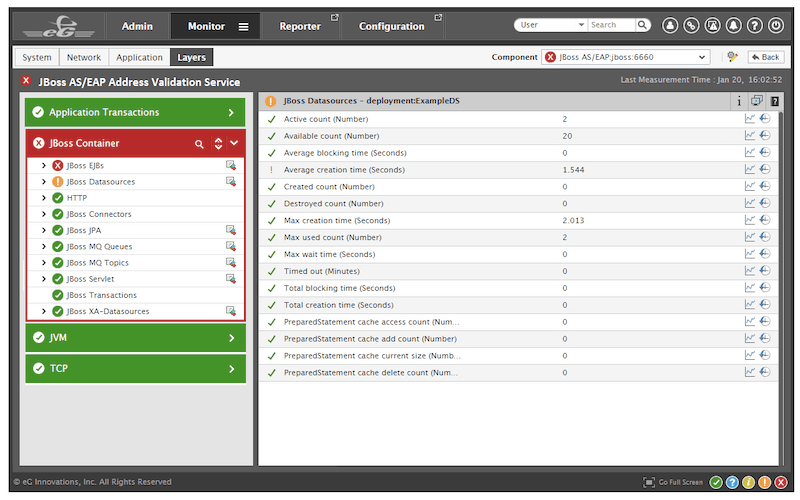
eG Enterprise from eG Innovations is a centralized application and infrastructure monitoring solution for cloud and on-premises deployments. eG Enterprise allows Real-User Monitoring (RUM), Synthetic User Monitoring, APM, cloud monitoring, and digital workspace monitoring.
The eG Enterprise software comes with a JBoss monitoring tool to ensure application performance. You can keep track of all the JBoss components, including infrastructure and services, from a single-pane-of-glass. In addition, get visibility into your JVM environments, Java Application Server, Java code, EJB containers, application code, database connections, and more.
- Track JVM and get insights into how to optimize JBoss JVM.
- Get performance KPIs to troubleshoot JBoss performance.
- Get diagnostics of JBoss performance such as Java transactions, EJB, Connectors, DataSource, and more.
- Out-of-the-box monitoring models for JBoss EAP and WildFly.
Pros:
- Can monitor a wide range of virtual host environments, making this truly suited for larger enterprises or MSPs
- Threshold-based altering can notify when VMs go offline, or become slow due to resource-related issues
- Offers root-cause analysis to help technicals solves issues faster, resulting in more uptime
Cons:
- No freeware version
Subscribe to get a 30-days free trial.
Final Words
In this post, we learned about the JBoss AS, including the differences between JBoss EAP and WildfFly. We also went through a brief installation and deployment process. In the last section, we provided a list of the top JBoss monitoring tools that can help you keep your application server and applications running at the highest performance.
But we only scratched the tip of the iceberg with JBoss. JBoss is immense and has a lot more to offer.
The only way to discover more is to dive in.
Install your favorite JBoss AS, either free community-based WildFly or Enterprise JBoss EAP. Deploy your Java applications and start monitoring the health and performance of your application server. Two of our favorite JBoss monitoring tools are APM SolarWinds Server & Application Monitor, and Cisco’s AppDynamics APM platform.
